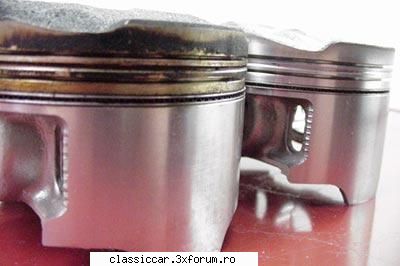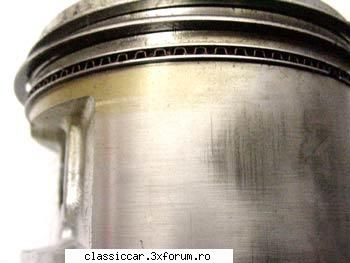knx
Membru Senior
 Din: Cluj Napoca
Inregistrat: acum 17 ani
Postari: 3319
|
|
Zilele astea tot ma fascineaza ceva, am sapat cred ca jumatate din internet dupa chestiile astea despre rodaj. In majoritatea manualelor asa scrie ca in timpul rodajului nu e voie sa se depaseasca 3500 rotatii, si/sau indicatii dintr-astea. Dar, alte manuale, de ex cel de Lada, asa zice ca poti duce masina pana la linia galbena de pe turometru, adica 5500 ture. Am citit foarte multe forumuri, posturi, si din ce spun oamenii, daca faci rodajul "dupa carte", in special la motoarele de speed-uri (motociclete de viteza), nu o sa mearga cum trebuie. Am citit multe pagini, ce am aflat e ca daca iti schimbi axul cu came, trebuie motorul lasat 15-20 minute intre 1500-2500 ture, recomandat sa fluctueze acceleratia. Tot asa trebuie acordata foarte mare grija la temperatura motorului, trebuie asteptat pana ce el se incalzeste. Acest proces se numeste la americani "Hard break-in". What's The Best Way To
Iata un citat de pe un site:
" Break-In A New Engine ??
The Short Answer: Run it Hard !
Why ??
Nowadays, the piston ring seal is really what the break in process is all about. Contrary to popular belief, piston rings don't seal the combustion pressure by spring tension. Ring tension is necessary only to "scrape" the oil to prevent it from entering the combustion chamber.
If you think about it, the ring exerts maybe 5-10 lbs of spring tension against the cylinder wall ... How can such a small amount of spring tension seal against thousands of PSI (Pounds Per Square Inch) of combustion pressure ??
Of course it can't.
How Do Rings Seal Against Tremendous Combustion Pressure ??
From the actual gas pressure itself !! It passes over the top of the ring, and gets behind it to force it outward against the cylinder wall. The problem is that new rings are far from perfect and they must be worn in quite a bit in order to completely seal all the way around the bore. If the gas pressure is strong enough during the engine's first miles of operation (open that throttle !!!), then the entire ring will wear into
the cylinder surface, to seal the combustion pressure as well as possible.
The Problem With "Easy Break In" ...
The honed crosshatch pattern in the cylinder bore acts like a file to allow the rings to wear. The rings quickly wear down the "peaks" of this roughness, regardless of how hard the engine is run.
There's a very small window of opportunity to get the rings to seal really well ... the first 20 miles !!
If the rings aren't forced against the walls soon enough, they'll use up the roughness before they fully seat. Once that happens there is no solution but to re hone the cylinders, install new rings and start over again"
E foarte interesant ce zice omul in acest articol, adevarul e ca si eu cu colegul meu am facut ceea ce credeam pana acum o prostie, cand am facut un motor, l-am lasat sa mearga 20-30 min, dupa care colegul nerabdator fiind, i-a dat in repetate randuri, progresiv ce e drept, aproape blana la viteze mici (~5500). Interesant e ca motorul a fumegat foarte putin, a fost "bleg" 200-300 km dupa care mergea foarte bine, fara batai. Pana si in ziua de azi merge excelent. La polul opus, un alt motor tot la care am facut rk, a fumegat destul de mult (~3-4 ore), am avut grija sa nu trecem de 3500 ture niciodata. De mers merge bine, dar e un pig bleg si in ziua de azi, ulei consuma cat e dat de fabrica, compresie are, fum nu scoate, batai nu are. Tare ciudata chestia. Iata ce am gasit si pt motoare aircooled 
"How to Properly Break In Your New or Rebuilt VW Engine
his next step is VERY IMPORTANT! Immediately bring the rpm's up to 2500 or higher. I vary the rpm's between 2500 and 4000, and do this for 15 minutes while keeping your eyes glued to the oil light! A second person back at the engine looking for oil or fuel leaks is a REALLY good idea too, since you don't want a fire or Valdez in your driveway! Most oil leaks will occur very soon after startup, if at all. Now, this is a nerve-racking experience to have the engine (it sure seems loud!) at these rpm levels when it's NEW, but if everything is OK, it's going to be fine. Remember that this engine is not even under a load, so it's not a big deal.
After the 15 minutes has elapsed, shut down the engine, and change the oil and adjust the valves. When you fire the engine up this time, you can let the engine idle, and make the needed carburetor adjustments. Drive the car easy, and change the oil and adjust the valves again after 100 miles or so.
Now that the "bearing break in" is done, you want to REALLY heat the engine up by driving it hard! This loads the rings and will break the pistons, cylinders, and rings in together. I have found that engines that are missing the flaps or thermostat assembly have a tough time seating the rings in, and the only cure for this (my experience) is to get the engine HOT (some of these engines "never" break in). Find a hill and drive full throttle up the thing a few times, in a gear that loads the engine down a bit. The loading and extra heat burns the glaze off the cylinders and allows everything to seat together well. I do not feel a longer "break in" period is needed (some say 10,000 miles) other than getting the rings seated, and this can be done in 500 miles. "
interesant, nu ?  
_______________________________________
Lada 1500 under construction !
Nu toate masinile vechi merita sa fie rable !
|
|










 , si surprinzator chiar e mult mai ok. Supapele ating temperatura de autocuratare mai repede, motorul nu fumega asa de mult => nu arde asa de mult ulei=>nu exista riscul sa se gomeze segmentii de ungere. Si dupa 350 km isi da drumul surprinzator mai mult decat m-as fii asteptat, consumul de ulei s-a oprit dupa nici o jumatate de ora de mers. Eu cred ca secretul consta in aplicarea progresiva a sarcinii, nu inainte de a incalzii bine de tot motorul.
, si surprinzator chiar e mult mai ok. Supapele ating temperatura de autocuratare mai repede, motorul nu fumega asa de mult => nu arde asa de mult ulei=>nu exista riscul sa se gomeze segmentii de ungere. Si dupa 350 km isi da drumul surprinzator mai mult decat m-as fii asteptat, consumul de ulei s-a oprit dupa nici o jumatate de ora de mers. Eu cred ca secretul consta in aplicarea progresiva a sarcinii, nu inainte de a incalzii bine de tot motorul.